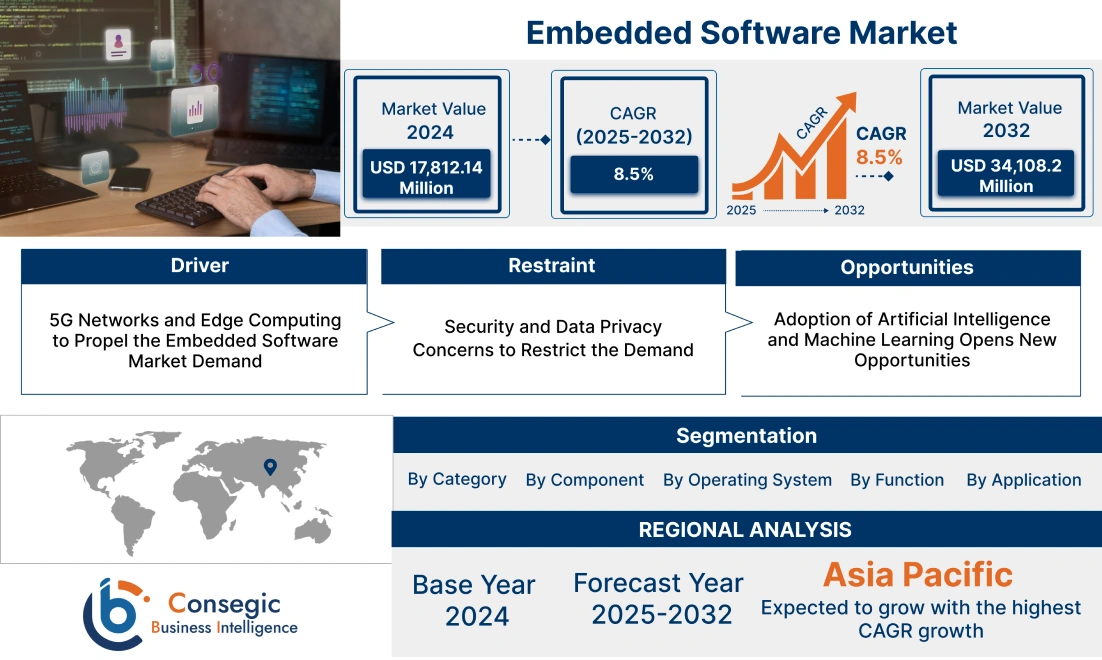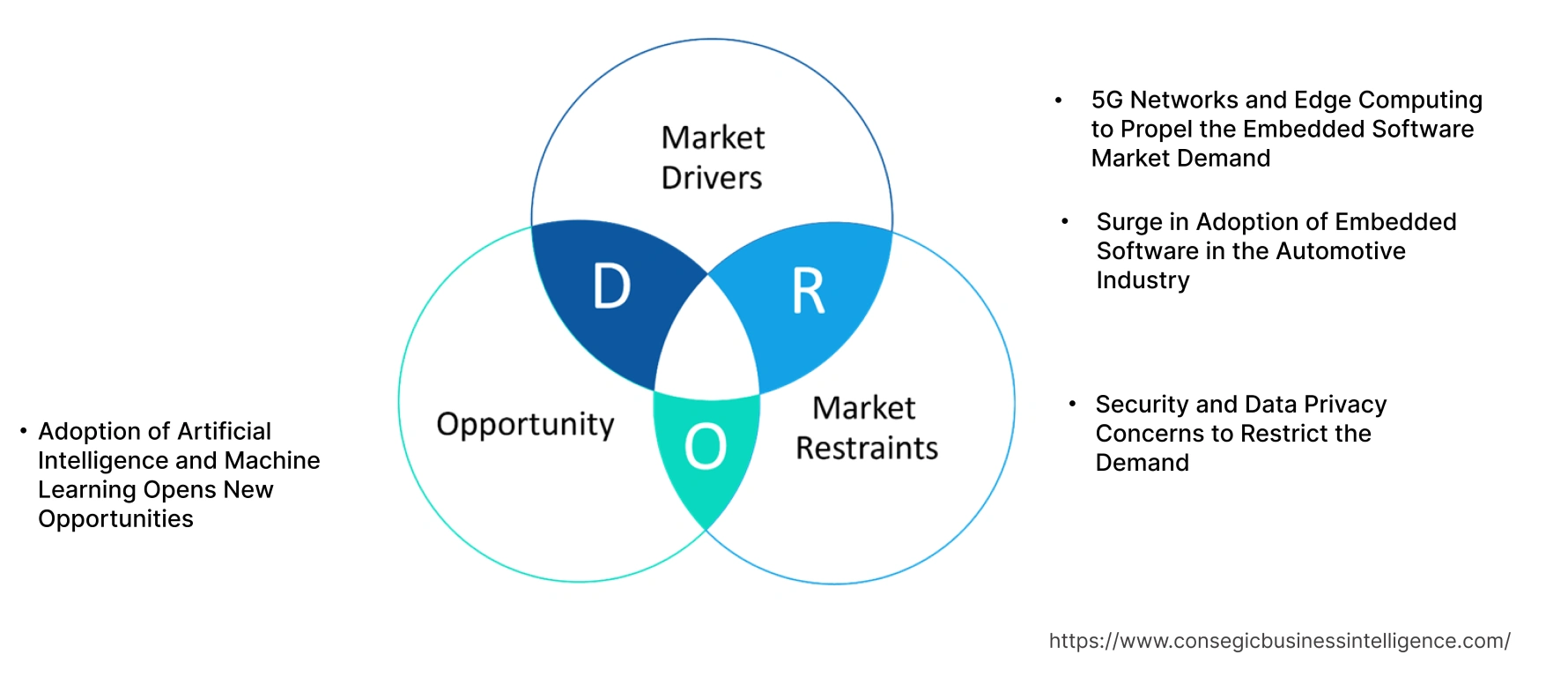- Summary
- Table Of Content
- Methodology
Embedded Software Market Size:
Embedded Software Market size is estimated to reach over USD 34,108.20 Million by 2032 from a value of USD 17,812.14 Million in 2024 and is projected to grow by USD 19,001.66 Million in 2025, growing at a CAGR of 8.50% from 2025 to 2032.
Embedded Software Market Scope & Overview:
An embedded software is described as a specialized type of software, which has the ability to control hardware devices such as machines, IoT devices, cars, and others. Moreover, it offers a range of benefits including hardware control, real-time responsiveness, energy efficiency, reliability, and cost-effectiveness. The aforementioned benefits are major determinants for increasing their deployment in automotive, aerospace, manufacturing, and other industries.
For instance, in January 2024, Green Hills Software achieved compliance certification against the ISO/SAE 21434 automotive cyber security standard. This makes Green Hills the first to be certified by Exida, a globally recognized company. The certification supports Green Hill's commitment to helping vehicle manufacturers fulfill UNECE WP.29 R155 regulation requirements and implement security measures across their processes. This strengthens Green Hill's existing partnerships with OEMs for designing and securing connected software-defined vehicles.
Embedded Software Market Insights:
Key Drivers:
5G Networks and Edge Computing to Propel the Embedded Software Market Demand
The embedded software market growth is being driven by the increasing adoption of 5G networks and the emergence of edge computing. The rise in 5G enables quicker more dependable connectivity thereby presenting openings for usage scenarios such as driverless cars, smart cities, and others. Edge computing deals with information nearer to its origin and enhances on-time reaction and effectiveness.
- In June 2024, according to Tessolve , embedded product design is being revolutionized by 5G as it provides more data rates, lower latency (under 1 ms), and increased reliability. It also allows for customization, facilitates edge computing in IoT devices, and improves mobile-to-embedded communication. These advancements have significant implications for industries like healthcare, automotive, and industrial automation.
Therefore, the aforementioned advancements in network and edge computing are driving the embedded software market.
Surge in Adoption of Embedded Software in the Automotive Industry
The automotive sector has experienced a significant increase in the adoption of embedded technology. Embedded software that is developed to use these advancements performs well in gathering and processing information using sensors and actuators hence enabling quick response to environmental changes. As vehicles become more connected and sophisticated, embedded technology plays a crucial role in enhancing safety, convenience, and overall driving experience.
Moreover, modern vehicles rely on embedded systems to process data from sensors (such as cameras, LiDAR , and radar) and make real-time decisions for features like lane departure warnings, adaptive cruise control, automated parking, and eventually fully autonomous driving. These systems are essential for propelling the automotive sector forward, and meeting consumer needs for enhanced infotainment, connectivity, and in-car entertainment experiences.
- In August 2021, eSOL and Real-Time Innovations(RTI) joined forces to support high-performance, secure embedded applications in automotive and industrial domains. RTI is famed for its Data Distribution Service (DDS) norm while on the other hand, eSOL is an RTOS seller with multi-core assistance for the Arm's CPUs. Both firms have integrated eSOL eMCOS with RTI Connext DDS. This collaboration empowers eMCOS developers to create distributed real-time systems using open standards and high-performance commercial off-the-shelf technology.
Key Restraints :
Security and Data Privacy Concerns to Restrict the Demand
Security and data privacy are important issues concerning embedded software because of the interconnectedness of devices. It is important to have a guarantee that sensitive information is securely stored and unauthorized access is prevented. Therefore, to address these concerns, it is necessary to consider various factors, such as implementing robust encryption, establishing secure methods for user identification during registration or network login, and performing regular system vulnerability checks.
- In July 2021, Mercedes-Benz was informed by an external security researcher who found out that not more than 1000 customers and potential buyers have their confidential data mistakenly hosted on a cloud storage platform. The affected data includes credit scores, driver's license numbers, social security numbers, and credit card information.
Therefore, the rising data security and data privacy concerns due to cyber-attacks, data breaches, and others are restraining the market.
Future Opportunities :
Adoption of Artificial Intelligence and Machine Learning Opens New Opportunities
The integration of Artificial Intelligence (AI) and Machine Learning (ML) is a key catalyst propelling the embedded software market. AI and ML enable embedded systems to learn from data, detect patterns, make decisions, and predict outcomes, enhancing applications like predictive maintenance, anomaly detection, automation, and personalization. The rise of complex embedded systems, such as autonomous vehicles, smart home devices, and advanced robotics, further drives the need for high-performance embedded software. As AI and ML adoption continues across various sectors, the embedded software market is set to expand.
- In December 2021, MicroAI , a leader in edge-native AI and ML software, unveiled MicroAI Security, a solution designed to safeguard critical assets, IoT devices, and industrial and manufacturing systems from cybersecurity threats. MicroAI Security offers a novel method to counter these threats, featuring an embedded AI algorithm that identifies, alerts, and visualizes cybersecurity intrusions in real-time on edge and endpoint-connected devices. The algorithm enables a connected device to self-monitor and issue alerts when it detects unusual behavior.
Hence, the rising adoption of AI and ML is anticipated to increase the utilization of embedded technology in turn promoting embedded software market opportunities during the forecast period.
Embedded Software Market Segmental Analysis :
By Category:
Based on the category, the market is segmented into bifurcated into software and service.
Trends in the category:
- Edge computing is a crucial aspect of many embedded applications because of the growing need for faster response times and heightened privacy requirements.
- The automotive industry is revolutionized by advancing features such as advanced driver-assistance systems (ADAS) and others.
The software accounted for the largest revenue share in the year 2024 and is anticipated to register the fastest CAGR growth during the forecast period.
- They are utilized in aerospace, military & defense, IT & telecom, and other industrial applications that require efficient resource utilization, real-time responsiveness, and seamless integration with hardware component solutions.
- They offer a variety of benefits, including device control, communication protocols, and data processing.
- In February 2024, AMD introduced AMD Embedded+, a solution that combines AMD Ryzen Embedded processors with Versal adaptive SoCs on a single integrated board. As a result, this system leads to scalable energy-efficient solutions, with long lifecycles for applications in the medical, industrial, and automotive domains. This helps ODMs bring new products to market more quickly.
- Therefore, according to the market analysis, the implementation of software in various sectors such as aerospace, military & defense, and others is driving the embedded software market trends.
By Component:
Based on the component, the market is segmented into operating systems, middleware, firmware, and application software.
Trends in the component:
- Embedded systems are commonly equipped with dual-core, quad-core, and even octa-core processors, enabling them to handle multiple tasks and more complex operations simultaneously.
The operating system accounted for the largest revenue share in the year 2024 and is anticipated to register the fastest CAGR growth during the forecast period.
- Operating system offers capabilities, such as resource management, user interface, and communication with devices.
- According to the analysis, they offer numerous advantages, such as efficient hardware use, running multiple applications, security management, and others.
- In April 2020, Microsoft made its Azure real-time operating system available to major MCU vendors like ST, Renesas, NXP, Microchip, and Qualcomm. The adoption of this operating system by these vendors was seen as an initiative to enable billions of IoT devices using MCUs to operate within Azure's environment.
- Thus, the market analysis concludes that the ability to connect with multiple devices and multiple applications in the operating system segment is driving the market trends.
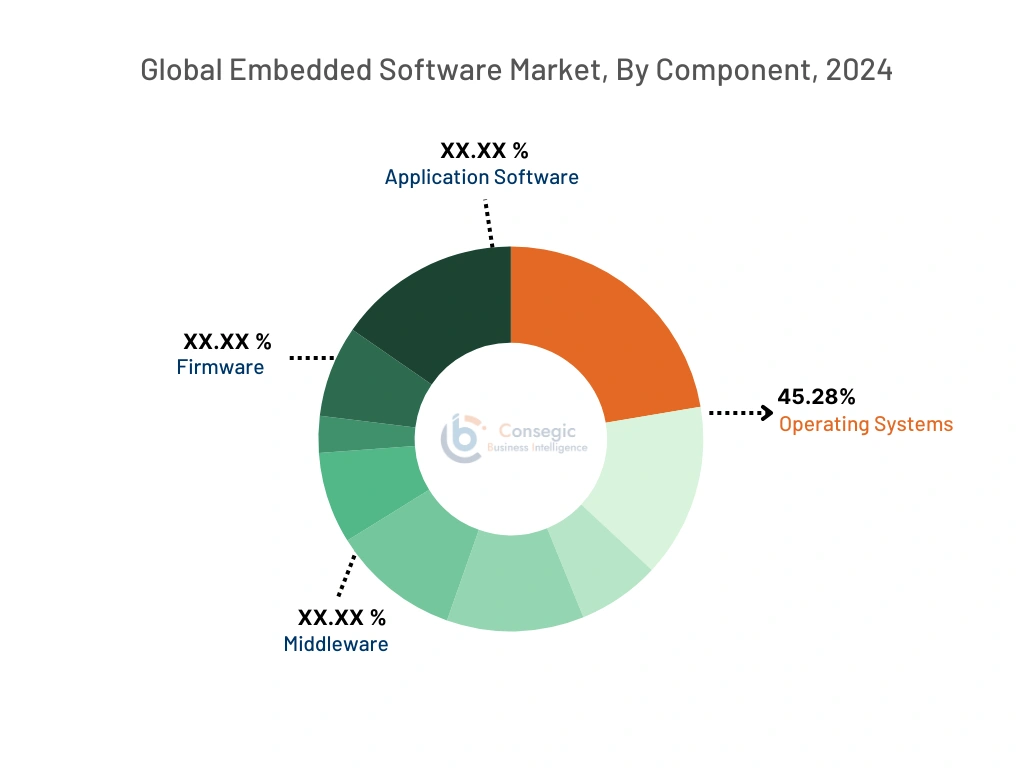
By Operating System:
Based on the operating system, the market is segmented into general-purpose operating systems (GPOS), real-time operating systems (RTOS), Linux, QNX, Windows, Android, VxWorks, and others.
Trends in the operating system:
- The increasing demand for minimal latency boosted the popularity of RTOS.
The RTOS accounted for the largest revenue share in the year 2024 and is anticipated to register the fastest CAGR growth during the forecast period.
- RTOS includes functionalities such as the ability to process data and events within strict time constraints, minimal interrupt latency, minimal thread switching latency, and the capability to interact with analog systems.
- They deliver a range of valuable benefits, including the capability to prioritize and divide application code, enhanced responsiveness of high-priority tasks, elimination of polling, and ease of incorporating middleware components. It also offers improved security and privacy and simplifies the development process. This makes it more expandable, maintainable, portable, and secure.
- In February 2024, the Zephyr Project, a Linux Foundation open-source initiative, was joined by Renesas Electronics Corporation, STMicroelectronics, and Ac6 as silver members. This project is primarily based on a proven RTOS ecosystem built by developers for developers, which is simple to deploy and manage.
- Thus, the data processing ability with minimal latency of RTOS is driving the embedded software market trends.
By Function:
Based on the function, the market is segmented into standalone systems, real-time systems, network systems, and mobile systems.
Trends in the function:
- Reconfigurable computing is a technology that lets hardware change its setup without needing to stop. This is useful for embedded systems that need to adapt to changing workloads or requirements.
- Wireless embedded systems are revolutionizing connectivity in the IoT Era with advancements in wireless solutions such as Z-Wave, Bluetooth, Wi-Fi, ZigBee, and others.
The mobile system accounted for the largest revenue share in the year 2024 and is anticipated to register the fastest CAGR during the forecast period.
- Mobile systems boast features such as controlling microprocessors, cameras, GPS, Bluetooth, and Wi-Fi to enable portable smart devices with advanced functionality and connectivity.
- They offer an array of benefits including enhanced performance, a robust app ecosystem, connectivity and IoT integration, power efficiency, security measures, and the potential for Augmented Reality (AR) and virtual reality (VR) applications.
- In April 2024, Qualcomm Technologies announced a significant advancement in Wi-Fi technology at the Embedded World 2024. Additionally, they unveiled new AI-ready IoT and industrial-embedded platforms. The aim of these platforms, along with a micro-power Wi-Fi SoC, is to enable intelligent computing.
- Thus, the ability of mobile systems to connect and control various components such as cameras, GPS, Bluetooth, and others is driving the software market trends.
By Application:
Based on the application, the market is segmented into segregated into Automotive, Aerospace, Consumer Electronics, Manufacturing, Healthcare, Military & Defense, IT & Telecom, and Others.
Trends in the application:
- The optimization of battery-powered devices for minimal power consumption and high uptime is driven by the increasing reliance on mobile and IoT devices.
- Automation in computers, robots, and other fields is boosting the embedded software market demand.
The consumer electronic segment accounted for the largest revenue share in the year 2024.
- This technology is utilized in consumer electronics and other industrial applications that require device control and management, connectivity IoT integration, and other solutions.
- Additionally, as per the analysis, the factors including the proliferation of smart home devices and the use of the internet are driving the consumer electronics segment. This is due to the increasing popularity of smartwatches, smart home devices, and voice assistants, as well as the growing need for smart speakers.
- In January 2023, Fluent.ai unveiled an embedded voice recognition solution developed in collaboration with Airoha, a subsidiary of Mediatek. This cutting-edge software supports offline speech recognition, even in noisy environments, and works with any language or accent. Users can perform more than 30 True Wireless Stereo (TWS) actions using 101 versatile voice commands, including tasks like enabling noise cancellation, controlling music playback, managing calls, and checking battery levels.
- Thus, the rise of smart home devices and others in the consumer electronic sector is driving the market trends.
The automotive sector is anticipated to register the fastest CAGR during the forecast period.
- The growth of the automotive segment is attributed to several factors including the incorporation of ADAS in vehicles, swift advancements in connected car services, growing adoption of semi-autonomous and autonomous vehicles, and others.
- In March 2024, General Motors (GM), Magna, a global automotive supplier, and Wipro Limited collaborated to create SDVerse, a B2B sales platform for automotive software.
- Therefore, the market analysis concludes that the use of this technology in the automotive sector to improve its efficiency is anticipated to boost the market during the forecast period.
Regional Analysis:
The regions covered are North America, Europe, Asia Pacific, Middle East and Africa, and Latin America.
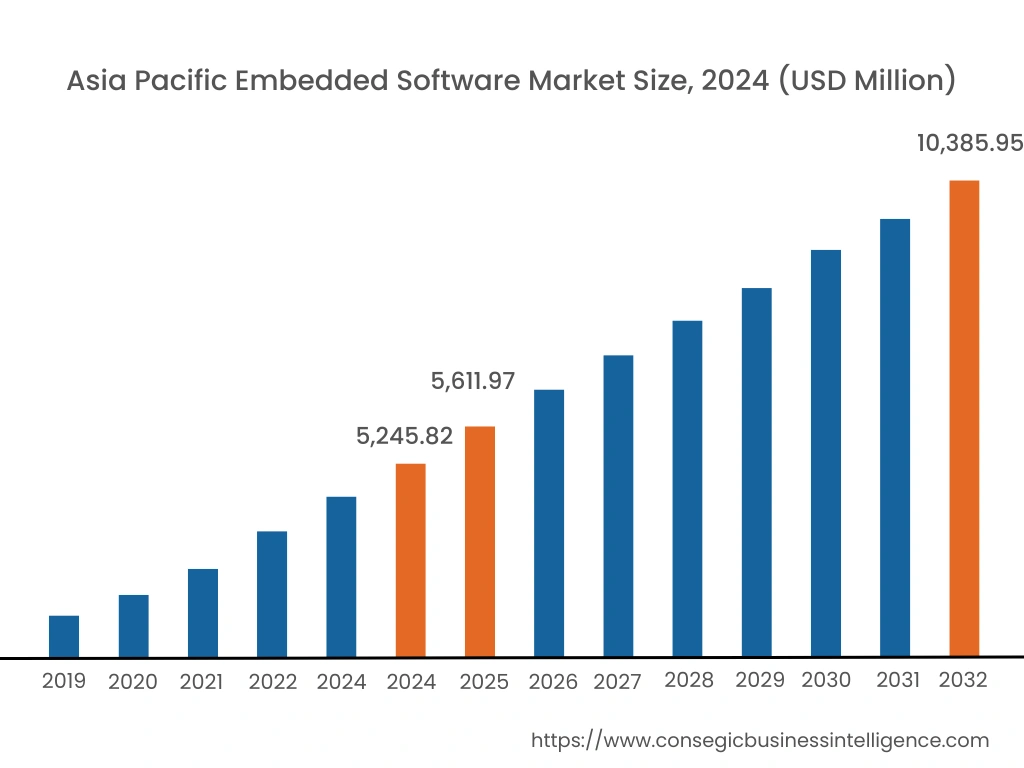
North America is estimated to reach over USD 11,054.47 Million by 2032 from a value of USD 5,908.43 Million in 2024 and is projected to grow by USD 6,290.96 Million in 2025. The market evolution is mainly driven by its deployment in consumer electronics, automotive, healthcare, industrial automation, and telecommunications, among others. These industries are increasingly relying on embedded systems for efficient device control, interactivity, connectivity, and optimized performance, thereby fueling market development.
- In January 2024, Valeo is expanding its software capabilities in North America to meet the growing demand in the automotive sector. This is due to the significant transformation taking place with the advent of electric, autonomous, and connected cars. Valeo offers embedded software solutions that contribute to safer, cleaner, and more affordable mobility. Additionally, they enable individualization of car functionalities from the time they are built until the end of their life cycle.
Furthermore, factors including increasing adoption of Internet of Things (IoT) devices are projected to drive the market in North America during the forecast period.
Asia Pacific region was valued at USD 5,245.82 Million in 2024. Moreover, it is projected to grow by USD 5,611.97 Million in 2025 and reach over USD 10,385.95 Million by 2032. Out of this, China accounted for the maximum revenue share of 34.2%.
The Asia Pacific region's growing adoption of IoT offers lucrative growth prospects for the market. Additionally, the prevalence of a large number of semiconductor manufacturing facilities in the region is driving the Asia Pacific market opportunities.
- In January 2024, Advantech formally set up the ASEAN Shared Service Center (ASSC) in Penang, Malaysia, to boost customer service in the Asia-Pacific region. The first project of ASSC was kick-started with the signing of a Letter of Intent (LOI) with Piacom, a system integrator (SI) associated with Petrolimex, a Vietnamese petroleum conglomerate.
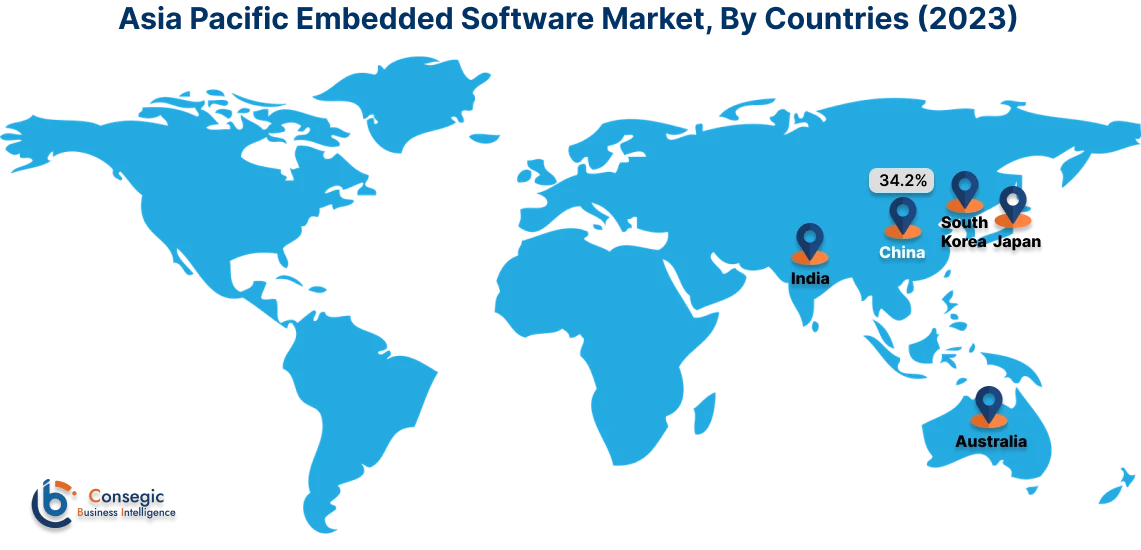
As per the embedded software market analysis, Europe is anticipated to witness substantial growth that is backed by the well-placed automotive and electronics sector. Companies invest in innovative technologies to cater to the surging need for software across regions.
The Middle East & African market is expected to show a moderate development rate during the forecast period. The rise of this technology helps farmers to implement efficient agricultural techniques and optimize the number of fertilizers, pesticides, water, and others which leads the agricultural sector, in turn, is anticipated to drive the embedded software market share.
There is growing infrastructure, digitalization, and attractive government policy for data center developments in the Latin American market depicting cumulative expansion in countries such as Colombia, Argentina, Chile, and others.
Top Key Players & Market Share Insights:
The embedded software market is highly competitive with major players providing software to the national and international markets. Key players are adopting several strategies in research and development (R&D), product innovation, and end-use launches to hold a strong position in the embedded software market. Key players in the embedded software industry include-
- Softeq Development Corp. (U.S)
- STMicroelectronics (Switzerland)
- Mitsubishi Electric Corporation (Japan)
- Microsoft (U.S)
- Emerson Electric Co. (U.S)
- Intel Corporation (U.S)
- Enea (Italy)
- Renesas Electronics Corporation (Japan)
- NXP Semiconductors (Netherlands)
- Microchip Technology Inc (U.S)
Recent Industry Developments :
Product Launches
- In June 2024, Percepio AB, announced Tracealyzer version 4.9. This release primarily aims to enhance the user experience for installing and operating Tracealyzer on a Linux host computer. The installation process has been significantly streamlined with a new standalone package that encompasses all the necessary components to run Tracealyzer.
- In December 2023, STMicroelectronics launched the STM32 ZeST (Zero Speed Full Torque) software algorithm. This algorithm, specifically designed for STM32 microcontrollers, enables sensorless motor drives to generate full torque even at zero speed.
Mergers & Acquisitions
- In May 2024, Accenture acquired Teamexpat, a Netherlands-based specialist in embedded software for high-tech products and systems. Teamexpat focuses on improving the production of microchips by using ultraviolet light to create intricate patterns on semiconductor materials. They achieve this through their expertise in software development, testing, and integration of lithography systems in the semiconductor.
- In December 2023, Lynx Software Technologies, a leading company specializing in the creation of fundamental, open architecture software solutions for the Mission Critical Edge, acquired Timesys Corporation. Timesys is known for providing development tools, cybersecurity solutions, and unique software engineering services for open-source embedded and edge software applications.
Partnerships & Collaborations
- In April 2024, Neusoft Reach Automotive Technology Co., Ltd., announced a strategic partnership with Ambarella, Inc. This collaboration leverages both party's robust resources and strengths in automotive software, autonomous driving technology, electrification, and AI system-on-chip (SoC) products. The companies aim to jointly advance product technology and market development.
- In June 2024, IAR announced a strategic alliance with AI Sweden, aiming to expedite Sweden's digital transformation. This partnership will enhance customer workflows, competitiveness, and innovation speed-to-market. The partnership will facilitate the integration of AI algorithms in embedded systems, enabling them to perform complex tasks and helping customers adapt to market changes.
Embedded Software Market Report Insights :
| Report Attributes | Report Details |
| Study Timeline | 2019-2032 |
| Market Size in 2032 | USD 34,108.20 Million |
| CAGR (2025-2032) | 8.5 % |
| By Category |
|
| By Component |
|
| By Operating System |
|
| By Function |
|
| By Application |
|
| By Region |
|
| Key Players |
|
| North America | U.S. Canada Mexico |
| Europe | U.K. Germany France Spain Italy Russia Benelux Rest of Europe |
| APAC | China South Korea Japan India Australia ASEAN Rest of Asia-Pacific |
| Middle East and Africa | GCC Turkey South Africa Rest of MEA |
| LATAM | Brazil Argentina Chile Rest of LATAM |
| Report Coverage |
|
Key Questions Answered in the Report
How big is the embedded software market? +
Embedded Software Market size is estimated to reach over USD 34,108.20 Million by 2032 from a value of USD 17,812.14 Million in 2024 and is projected to grow by USD 19,001.66 Million in 2025, growing at a CAGR of 8.50% from 2025 to 2032.
What specific segmentation details are covered in the embedded software report? +
The embedded software report includes specific segmentation details for category, component, operating system, function, application, and region.
Which is the fastest segment anticipated to impact the market growth? +
In the application segment, the automotive sector is the fastest-growing segment during the forecast period due to the rising adoption of embedded software in automobile electronics systems including ADAS, and others.
Who are the major players in the embedded software market? +
The key participants in the embedded software market are Softeq Development Corp. (U.S), STMicroelectronics (Switzerland), Intel Corporation (U.S), Mitsubishi Electric Corporation (Japan), and Microsoft (U.S), Emerson Electric Co. (U.S), Enea (Italy), Renesas Electronics Corporation (Japan), NXP Semiconductors (Netherlands), Microchip Technology Inc. (U.S), and others.
